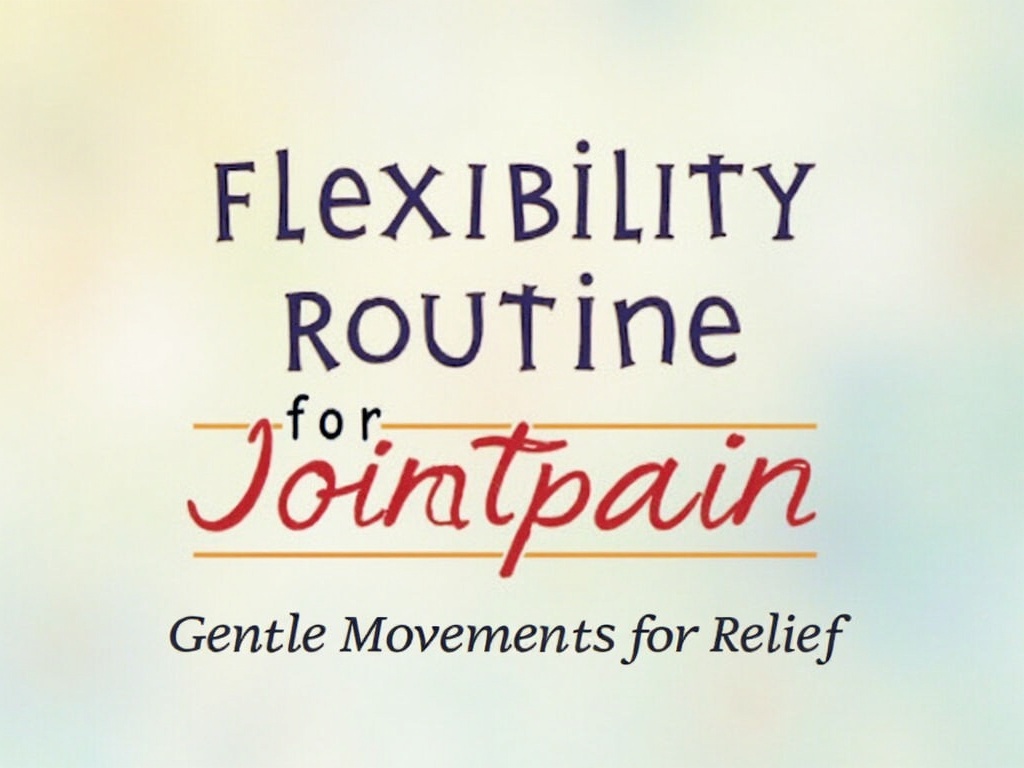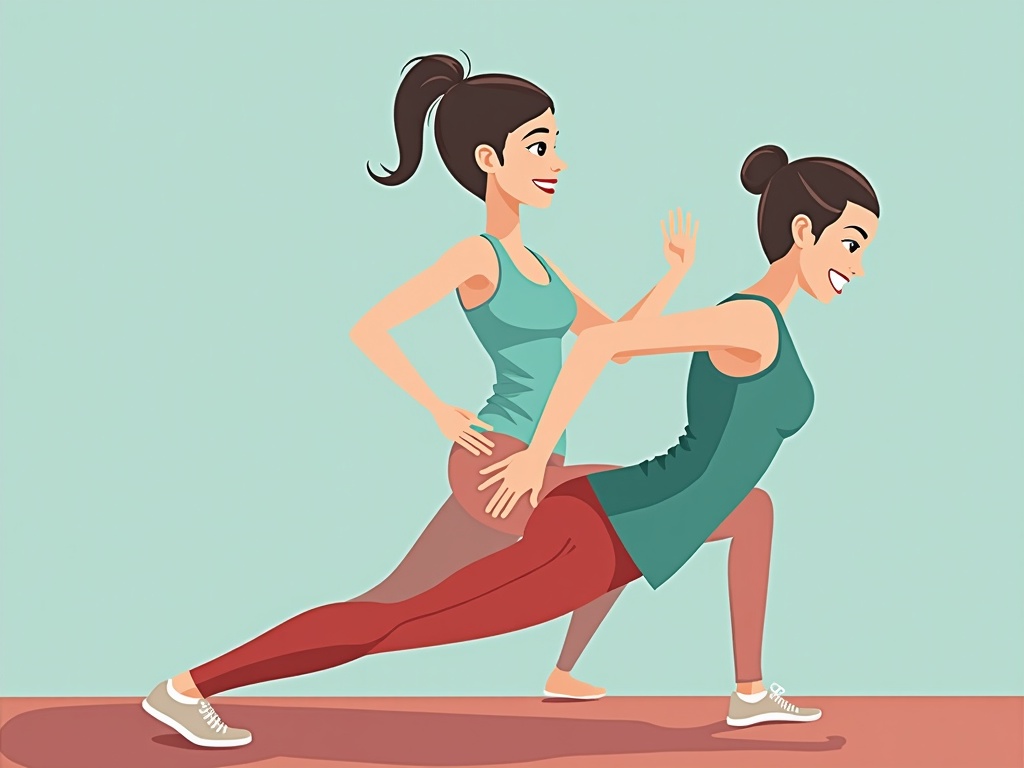Daily Flexibility Routine for Joint Pain: Gentle Movements for Relief
Imagine waking up without that familiar ache in your knees, the stiffness in your back, or the twinge in your shoulders. For many, joint pain is a constant companion, making even simple movements a challenge. But what if you could ease that discomfort and improve your mobility with a daily routine that's gentle, effective, and takes just a few minutes? This article explores a flexibility routine designed specifically to target joint pain, helping you reclaim your body and your day.
Understanding Joint Pain and the Role of Flexibility
Joint pain can stem from various sources, including arthritis, injuries, and overuse. Regardless of the cause, the underlying issue is often inflammation and stiffness in the joint. Flexibility exercises can help combat this by:
- Increasing Blood Flow: Gentle movements encourage circulation to the joint, delivering vital nutrients and flushing out inflammatory substances.
- Lubricating the Joints: Synovial fluid, the lubricant in your joints, needs movement to circulate properly. Flexibility exercises help keep your joints well-oiled.
- Strengthening Supporting Muscles: Improved flexibility often leads to better muscle balance, providing greater support and stability for your joints.
- Reducing Stiffness: Regular stretching helps to break up adhesions and improve the range of motion, decreasing stiffness and pain.
Before starting any new exercise routine, it's crucial to consult with your doctor or physical therapist, especially if you have a pre-existing condition. They can help you tailor the exercises to your specific needs and limitations.
A Gentle Daily Flexibility Routine
This routine focuses on gentle, low-impact movements that can be performed daily to improve joint flexibility and reduce pain. Remember to listen to your body and stop if you feel any sharp or worsening pain. Aim for slow, controlled movements and deep, even breathing throughout.
Neck Stretches
Why: Relieves tension and improves range of motion in the neck, often affected by poor posture and stress.
- Chin Tuck: Gently draw your chin towards your chest, as if making a double chin. Hold for 5 seconds, repeat 10 times.
- Head Tilts: Slowly tilt your head towards your right shoulder, feeling a stretch on the left side of your neck. Hold for 5 seconds, repeat on the left side. Do 5 repetitions on each side.
- Head Rotations: Gently turn your head to the right, looking over your shoulder. Hold for 5 seconds, repeat on the left side. Do 5 repetitions on each side.
Shoulder Rolls
Why: Improves shoulder mobility and reduces stiffness.
- Forward Rolls: Gently roll your shoulders forward in a circular motion for 10 repetitions.
- Backward Rolls: Repeat the movement, rolling your shoulders backward for 10 repetitions.
Arm Circles
Why: Improves shoulder joint flexibility and circulation.
- Small Circles: Extend your arms out to the sides and make small, controlled circles forward for 10 repetitions.
- Large Circles: Increase the size of the circles, continuing forward for another 10 repetitions.
- Reverse: Repeat small and large circles, this time moving backward.
Wrist Rotations
Why: Relieves stiffness and improves mobility in the wrists, helpful for those who type or perform repetitive hand movements.
- Clockwise Rotation: Gently rotate your wrists in a clockwise direction for 10 repetitions.
- Counter-Clockwise Rotation: Repeat the movement in a counter-clockwise direction for 10 repetitions.
Finger Stretches
Why: Improves flexibility in the finger joints, reducing stiffness and pain.
- Finger Extension: Extend your fingers straight out and gently pull back on each finger towards your body. Hold for 5 seconds, repeat 5 times on each hand.
- Finger Flexion: Make a gentle fist and then slowly release your fingers. Repeat 10 times on each hand.
Torso Twists
Why: Improves spinal mobility and flexibility in the core muscles.
- Seated Twist: Sit comfortably in a chair with your feet flat on the floor. Gently twist your torso to the right, holding onto the back of the chair for support. Hold for 5 seconds, repeat on the left side. Do 5 repetitions on each side.
Hip Circles
Why: Improves hip joint mobility and reduces stiffness.
- Standing Hip Circles: Stand with your feet shoulder-width apart and place your hands on your hips. Gently make circular motions with your hips, first clockwise for 10 repetitions, then counter-clockwise for 10 repetitions.
Knee Extensions
Why: Improves knee joint flexibility and strengthens surrounding muscles.
- Seated Extension: Sit in a chair with your feet flat on the floor. Extend one leg straight out in front of you, hold for 5 seconds, and then slowly lower it back down. Repeat 10 times on each leg.
Ankle Rotations
Why: Improves ankle joint mobility and reduces stiffness.
- Clockwise Rotation: Gently rotate your ankles in a clockwise direction for 10 repetitions on each ankle.
- Counter-Clockwise Rotation: Repeat the movement in a counter-clockwise direction for 10 repetitions on each ankle.
Toe Curls
Why: Improves flexibility in the toe joints and strengthens the muscles in the feet.
- Seated Toe Curls: Sit comfortably in a chair and curl your toes under, holding for 5 seconds. Repeat 10 times on each foot.
Tips for Maximizing Your Flexibility Routine
Consistency is key when it comes to managing joint pain with flexibility exercises. Here are some tips to help you make the most of your daily routine:
- Warm-up: Before starting your stretches, do a light warm-up, such as marching in place or gentle arm swings, for 5-10 minutes. This will increase blood flow to your muscles and prepare them for stretching.
- Listen to Your Body: Never force a stretch. You should feel a gentle pull, but not pain. If you experience any sharp or worsening pain, stop the exercise immediately.
- Breathe Deeply: Focus on taking slow, deep breaths throughout the routine. This will help you relax and improve blood flow.
- Stay Hydrated: Drinking plenty of water helps keep your joints lubricated and reduces stiffness.
- Be Consistent: Aim to perform this routine daily, even if it's just for a few minutes. Consistency is key to seeing results.
- Modify as Needed: Don't be afraid to modify the exercises to suit your individual needs and limitations. You can perform the stretches while seated if standing is difficult.
- Cool-down: After your stretches, take a few minutes to cool down with some gentle movements and deep breathing.
Beyond Flexibility: A Holistic Approach to Joint Pain Management
While a daily flexibility routine can significantly improve joint pain, it's important to consider a holistic approach that incorporates other lifestyle factors:
- Healthy Diet: A balanced diet rich in fruits, vegetables, and omega-3 fatty acids can help reduce inflammation and promote joint health.
- Weight Management: Excess weight puts extra stress on your joints, particularly your knees and hips. Losing weight can significantly reduce joint pain.
- Low-Impact Exercise: Activities like swimming, walking, and cycling are gentle on your joints and can help strengthen muscles and improve overall fitness.
- Proper Posture: Maintaining good posture can help prevent strain on your joints and reduce pain.
- Stress Management: Stress can exacerbate joint pain. Practicing relaxation techniques such as yoga, meditation, or deep breathing can help manage stress levels.
- Assistive Devices: Consider using assistive devices such as canes, walkers, or braces to provide support and reduce stress on your joints.
The Power of Small Changes
Living with joint pain can be challenging, but it doesn't have to define your life. By incorporating a daily flexibility routine and adopting a holistic approach to joint pain management, you can take control of your health and improve your quality of life. Remember, even small changes can make a big difference. Start with a few simple stretches each day, and gradually increase the duration and intensity as you feel comfortable. With consistency and patience, you can reclaim your body and enjoy a more active, pain-free life.


